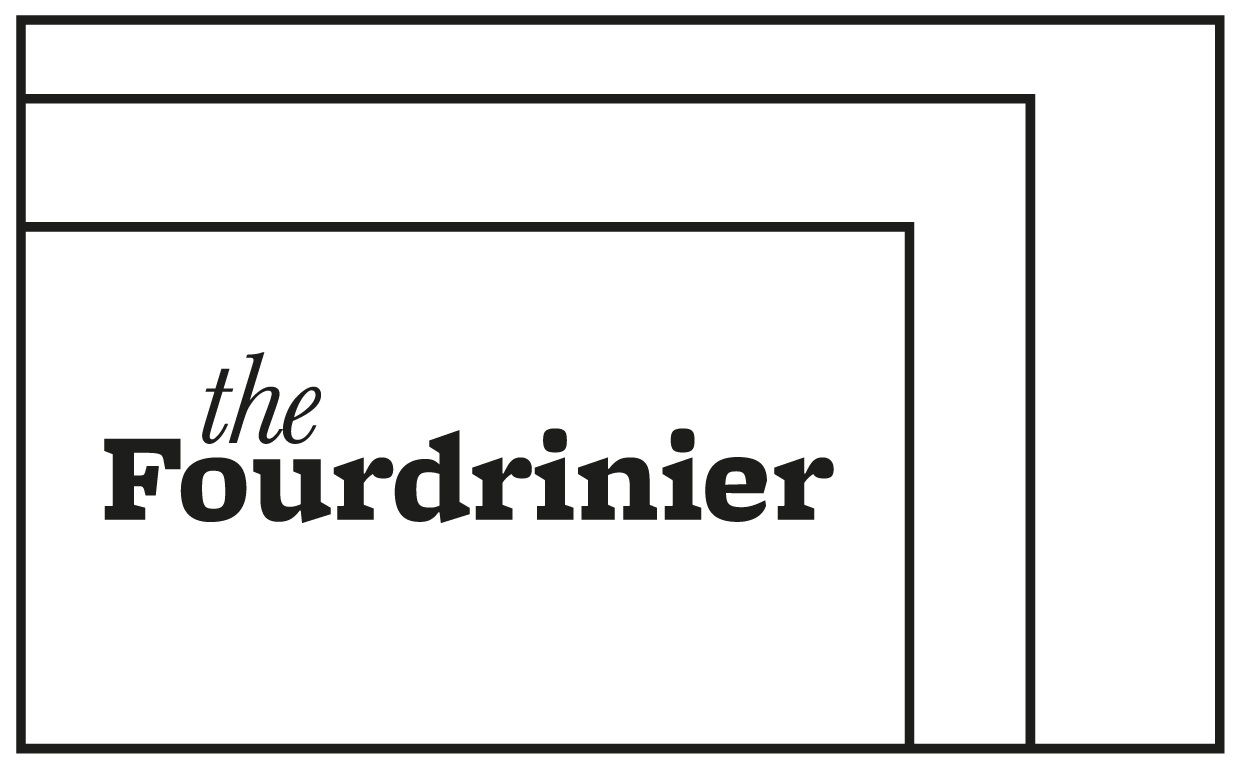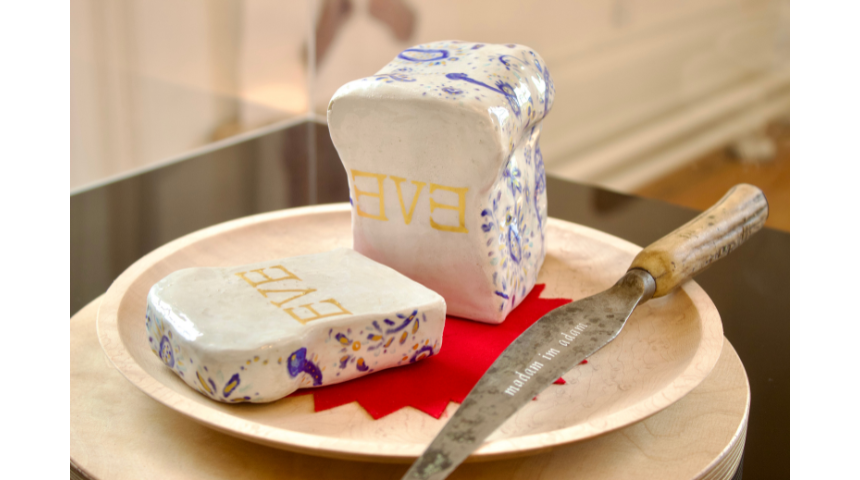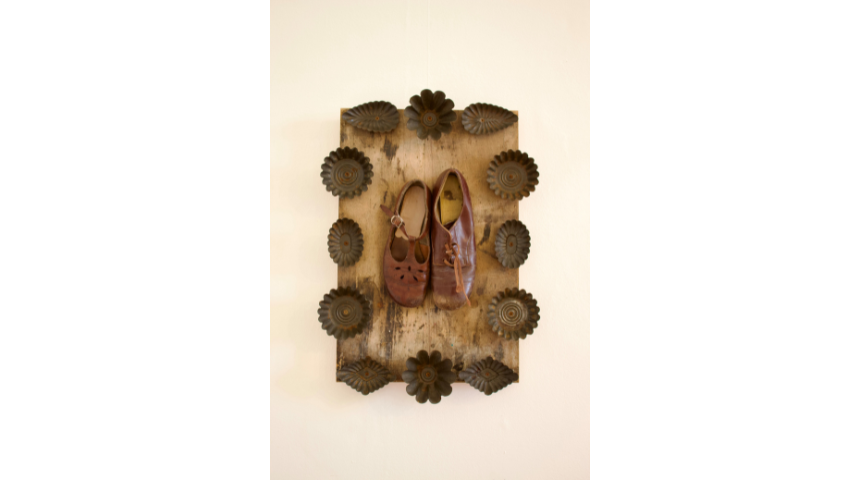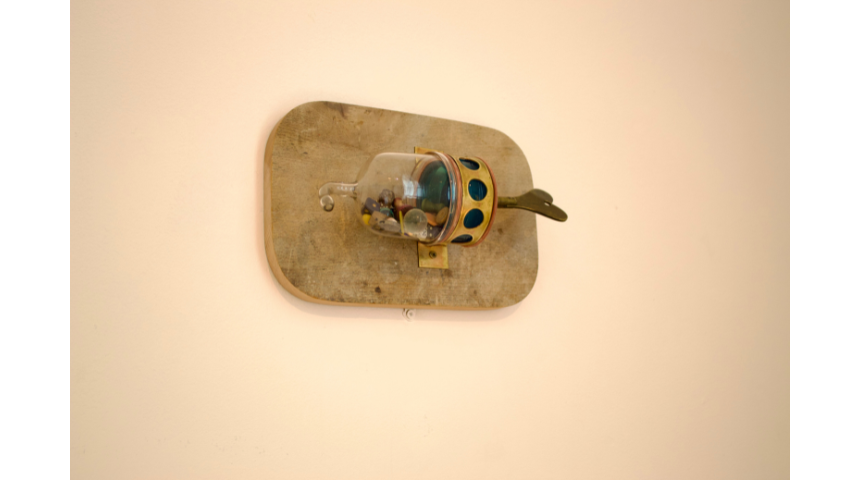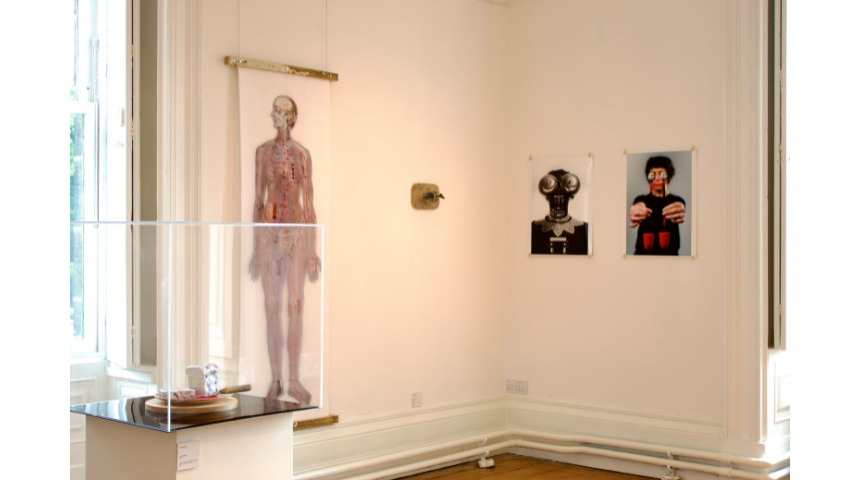REVIEW Jul 2025 ‘Apologues; An awkward combination of things’ by Luce Bergman at The Whitaker
Jo Manby
Luce Bergman Eucharistia (2025) photo Lydia McCaig
Surrealism is a cultural frame of reference that all sections of society draw upon. Advertising, branding, social media, comedy, as well as the arts. It’s built into our everyday conversations and our descriptions of our day to day experiences, a way of reporting on the quirky or unusual or out of place. On show at The Whitaker, Rossendale, artist and visual communication academic Luce Bergman exhibits ‘Apologues; An awkward combination of things’. Surrealism is alive and well in Bergman’s interpretations of a Victorian scrapbook, which addresses the traditional binary opposition of ‘Ladies’ and ‘Gentlemen’. the Fourdrinier editor Jo Manby spoke to Bergman about her in-depth explorations of The Whitaker Museum’s collections, and also caught up with Creative Director Gaynor Seville on what makes The Whitaker’s exhibition programming such a success with audiences and artists alike. Sarah Joy Ford’s show Dykeland: Volume 1 is also currently showing in the main gallery upstairs. Both exhibitions run until 21 September 2025. Free entry.
https://www.thewhitaker.org/whats-on-article/contemporary-art-exhibitions/apologues-luce-bergman/
Luce Bergman is a maker of things, an artist with a fondness for wordplay and double-entendre who creates out of a place where the subconscious and the irrational are always simmering in the background. Give her a museum collection to play around with and she is in her element.
Bergman has transformed the lower floor gallery into a surrealist’s den of gauche visual puns and rhymes, witticisms that might be made by people of any age if so inclined but which hark back to the gags and lore of the playground. ‘Apologues; An awkward combination of things’ takes its name from a type of short story or fable with a simple moral message, often peopled by animals or objects. The etymology of the word apologues is the Greek apologos, or narrative.
Take Eucharistia (2025), an assemblage in the centre of the gallery. A ceramic loaf of bread has been decorated by Bergman with a Delft-like blue pattern that appears to be floral but on closer inspection is all about genitalia. Flashes of blue shaped like Medieval nun’s visions that can’t be anything else but female vulvas. Blue phallic diagrams mimicking teenage graffiti. A ceramic slice has been cut from the ceramic loaf with a knife etched with the palindrome ‘madam I’m adam’ across the blade. The cut bread reveals in gilt letters the word EVE, mimicking the way the word Blackpool runs all the way through Blackpool rock.
The title of the work Eucharistia Bergman explained to me relates to her research into the word ‘lady’: it comes ‘from the term hlæfdige - loaf maker – the bread-keeping woman of the household.’ Bread connects with the idea of breaking bread to symbolise the body of Christ and how ‘even the lowly loaf had been taken from woman and transubstantiated into a male saviour symbol. The breadwinner.’ Eve becomes embodied as a sacred loaf, while Adam is represented by an old bread knife belonging to Bergman’s grandad, which he used every day. ‘I used a palindrome again here to compound that sense of things being back to front, the man as woman, interchangeable - looping going backwards and forwards.’ Such a work typifies the way Bergman’s mind works. She is constantly following up connections and resonances between objects, thoughts and memories, drawing on a rich cultural pool of ideas.
The whole exhibition is sparked off and complimented by one specific museum object which exemplifies the strictures of the gender binary. Bergman decided to focus her attention for the exhibition on a Victorian Commonplace book she found in the museum collection and create a group show around one page in particular. The book, made by a Miss Susan Knowles and dated 1865, contains bits and pieces of psalms, advice, information about ‘a woman’s place’, duty, God, faith. Each page of the scrapbook is a contribution from a different friend or acquaintance, like a Victorian Instagram grid with shares and collaborations and reposts.
One specific page caught Bergman’s eye, entitled ‘Advice Gratis’ (free advice). A small square aperture, advent calendar-style. Open the little door, and a piece of sheet music is visible with two clefs, the top one with the word ‘Ladies’ and a B natural note; ‘Gentlemen’ on the one below with a B sharp note. Bergman was fascinated by these gendered assignments. Ladies should be natural, and gentlemen should be sharp – one eschew artifice and pretence, and the other be witty, erudite and smart? Such a wry observation so cleverly expressed by such subtle means.
Luce Bergman Self Portrait Age 49 (2025) photo Lydia McCaig
Bergman was offered an exhibition of her own in 2023 after responding to an artist call out. She had by that point seen a fair bit of the collections: ‘It was a privilege to have access to all of this. These kinds of things: old shoes, carpentry tools, delicate china, bird’s eggs, scrapbooks and letters, there’s a story behind all of it, someone’s life.’ She describes her process, how when so many things are ‘just aesthetically beautiful, when you begin laying them out in an ordered way or juxtaposing them with other things, dialogues start to form, deeper symbolism’. Sifting through what other people might see as pure junk, she likes to ‘follow the threads that begin to reveal themselves to me when I look at a particular thing. A scrap of remembered Biblical reference or Feminist theory joins with moments from my own life and finds a voice in the saved guts of an old telephone mechanism.’
Bergman initially proposed a collaborative show where a number of artists would be invited to respond to the same Commonplace book page and have their work exhibited together. However, in the event, Gaynor Seville, Creative Director at The Whitaker, offered her a solo show. Bergman also put out her own call-out for artist responses to the page, with certain parameters; about 60 people were asked initially and at the time of writing Bergman had 35 complete pages. She wanted to create something new for The Whitaker’s collection that connected to the past and the future.
‘I thought a lot about my existential struggles with Instagram, the guilt I often feel about staring at my phone,’ Bergman reflected, ‘skimming through images and the number of things I “bookmark” because they move me but ultimately never return to because there’s always more - more incredible imagery, more poetry that cuts to the heart, more beauty and pain and life being captured and presented in these little square digital frames.’ She made the point that ‘Instagram is our commonplace book, which is fine but I wanted to make something tangible, with weight and different textured pages.’
Bergman asked contributors for square pages for her Advice Gratis book, pages sent in the post that she could collate and bind together. ‘I invited people to respond to the original Advice Gratis page in any way they chose, either by sending their own free advice, exploring notions of gender or even simply presenting a complex idea in a humorous and simple graphic form.’ The unique original resulting book will be acquired by The Whitaker museum, but there will also be around 150 print copies on sale in The Whitaker shop.
Susan Knowles’ Commonplace book, open at the page, is on display in a glass case at the entrance to Bergman’s exhibition. Inside, once you know the backstory of the show’s initial inspiration, it’s easy to fall into step with the awkwardness that Bergman alludes to in her subtitle to ‘Apologues – An awkward combination of things’. When I go to The Whitaker to meet Bergman and see the work during installation, ahead of the opening on 6 June, there is a slight awkwardness in the way we meet that fits with the delicate social negotiations that are the subtext of most of these works. I arrive in the front carpark area of The Whitaker’s approach just as a woman gets out of a car ahead of me. She half turns and smiles briefly, and I smile back, but neither of us is quite sure if we are who we have come to see. Bergman ends up walking ahead and disappearing into the galleries while I go and drink peppermint tea until the official time of our meeting. So when we do meet, it’s funny and fitting.
The first object that Bergman shows me when she gives me a tour of her show is Chip in a Bottle (2025). She laughs, ‘I spent hours whittling the wooden chip’, she says, ‘and the bottle [a greasy spoon vinegar bottle] is just something I found.’ All the works have this wartime ‘make-do-and-mend’ look about them. There are lots of found objects that Bergman has then had to find a way of joining together. These ‘joiners’ are ‘either functional things such as brass brackets, wooden cabinets, or moving mechanisms - or they were items which helped construct the narrative such as handmade ceramic eggs or golden hands.’ They are the kind of things a grandfather used to make for a grandchild – a load of interesting bits and pieces stashed away in a shed at the bottom of the garden, and they’d clamp bits together to make a little figure or a boat or an absurd object. Bergman is like the child who learned these tricks from their grandad at a young age and never lost the habit.
Many of the works are hugely poignant. In Nest Eggs, 1, 2 and 3 (lower, middle and upper) (2025), three-tiered bird’s nests are adorned with red swatches of ricrac braid, extruded from the mouths of little antique leather purses, unmistakably representing fledglings and equally emphatic is the message, ‘hungry mouths to feed.’ Bergman cites all those phrases about the lived reality of so many people whose money won’t stretch, who are not made of money, for whom money doesn’t grow on trees. ‘Most of the work for Apologues was created by placing seemingly incongruous things together to express visceral experiences or suggest broader narratives entangled with the business of being human, being female, being other.’ Through a fusion of the natural world with technology, Bergman aims to ‘communicate a sense of human interference with the natural order of things but also contrary to that, how that human interference can result in beautiful and useful objects which help us make sense of our inner world and interpersonal relationships.’
Luce Bergman Binary Codexxx (for Ashby) (2025) photo Lydia McCaig
Binary Codexxx (for Ashby) (2025) presents a rude hand gesture as a semi-automaton assemblage piece comprising a masculine pointing hand and an encircled thumb and forefinger representing the feminine. It also stands for the zero and one of binary code, relating to Black Box Theory in cybernetics whereby a device, system or object produces useful outputs but with nothing known about its internal workings.
I later asked Bergman to expand on how cybernetics relates to her work as an artist. It was difficult to summarise, she said, but she met Claudia Ascott, the daughter of Roy Ascott the British Cybernetic artist and pedagogical theorist. ‘We had an immediate connection and began to discuss ways that I might work with her to help support the newly formed Roy Ascott Archive & Artworks. Roy is 90 and shamefully under celebrated in terms of his contributions to experimental and formal arts education, his artwork is held at the Tate and collections all over the world but rarely included in contemporary shows.’
Bergman herself works part-time as a Senior Lecturer of BA Visual Communication at Leeds arts University and presented a research proposal which would explore Ascott’s radical approach to arts education and his exploration of cybernetic theory to improve student relationship with criticality. ‘Giving and receiving criticism is something that most students tend to struggle with and this is something I was driven to explore.’
Bergman explained that Ascott's educational philosophy emerged from his understanding of cybernetics as applied to learning systems. His seminal essay "The Construction of Change" (1964) articulated a vision of education where "the teacher is not an instructor but a guide, not a dictator but a participant in the learning process." Ascott's concept of "schools as organisms", said Bergman, ‘draws explicitly from cybernetic theory, particularly W. Ross Ashby’s insights into feedback loops and adaptive systems.’
Bergman’s research into Cybernetics and Behaviourism began to influence in the work she was making for ‘Apologues’. ‘I started to recognise a kind of feedback loop system between myself and the objects or material processes I was using. There was a lot of trial and error and the process became part of the work itself.’ Describing the combination of investigative and performative elements to her artistic research approach, Bergman explained how ‘Cybernetic theory applies to the way I make work but is also present in some of the themes of the pieces such as Binary Codexxx, which is a cheeky response to Ashby’s black box theory or Media & Child which is inspired by Richard Brautigan’s Cybernetic Poem All watched Over By Machines of Loving Grace.’
Bergman has a longstanding association with The Whitaker, having worked with Noah Rose the artist and sculptor on a film piece that was commissioned to connect the more functional feel of the Old Stables with the rest of the museum. ‘The plan was to create a film which would shine a light on the objects in the museum collections which were probably too ordinary to make it out into the gallery spaces.’ Extraordinary Mundane (2023) spent time in the Old Stables but was then moved into the children’s area upstairs. ‘The soundtrack was created in collaboration with musician Fraser Hinchliffe, we collected sounds made by domestic objects such as cheese graters, bottles and pans and used a beautiful old harmonium... I wanted the whole piece to sound tactile, rather than just a digital projected file.’
Luce Bergman Chancer (2025) photo Lydia McCaig
They also collaborated on the three-dimensional The Chandelier of Illuminated Objects (2023). ‘Noah and I both felt the room needed something else in it, something physical that would connect to the film but also be a tactile thing – a different form of animation. So, we conceived the idea of a chandelier, something usually found in a grand old dining hall and made from precious materials – but this one would be made from all the fascinating everyday objects hidden away in the museum stores.’
Bergman was full of praise for The Whitaker Creative Director Gaynor Seville and her carte blanche approach. ‘It’s great being in the same gang as other artists who have shown here, like Aideen Barry, and those who have also been fascinated by the Whitaker collection, such as Paula Chambers,’ Bergman says, conscious of showing in a place where so many other leading contemporary artists have exhibited. Seville, she says, is ‘generous of spirit and very trusting… she never asked to see anything in advance. She can tell if someone is going to deliver. Even though the exhibition is strongly object-based, there was no initial idea of this. It’s what makes the place so unique and successful.’ It’s the kind of free rein she would expect from a Develop Your Creative Practice award: ‘genuine development, a couple of years to do it in, let’s see what happens.’ All of Bergman’s pieces for this show were made with the space and the collection in mind: ‘it’s site-specific in that sense; it feels really right here.’
I later get the opportunity to ask Seville about the way she programmes at The Whitaker. ‘My approach is to always allow artists as much freedom as possible and to encourage brave approaches.’ I ask how easy is it to attract a contemporary visual arts audience: ‘ I am a firm believer that contemporary art audiences don’t just live in or visit city centres! Whilst we do attract audiences from Manchester, Leeds and surrounding cities, who come especially for the art exhibitions, our local communities and audience are as willing to be challenged and to experience contemporary artwork. Our recent opening event for Jamie Holman’s exhibition attracted 200 people on a cold wet Thursday evening. Many major city centre venues would find it hard to attract numbers like that.’
Seville describes how The Whitaker has been loved for generations in this area, telling me how people love coming back to see the exhibits they remember seeing as children. ‘We now change the exhibits around regularly so that more of the collections can be seen. Through the contemporary exhibitions many artists explore the space between the collection and their own work, this brings new perspectives on the collections, as well as new artistic experiences that visitors enjoy.’
Asked what successful programming looks like, Seville visualises exhibitions ‘that make the familiar spaces of The Whitaker feel new and alive. When work is presented in such a way to stop you in your tracks, and make you want to return to the gallery space again and again, I know it’s a success.’ Part of this is the ethos. ‘We go out of our way to try to help and accommodate artists, and our volunteer install team are incredible at helping artists to realise their vision of their artwork displayed in the building. We are a small charity reliant on volunteers and visitor donations so don’t have large budgets for technicians and install so I am proud of the professional and very caring operation we can provide.’
Seville has always been passionate about supporting local and emerging talent. ‘I do this by offering free 1-1 support and mentoring sessions. I have set up an artists’ professional network where I programme a range of talks, advice sessions and opportunities to network. Every year we have a new graduate award where one graduate gets a first solo show and mentoring support from me.’ Finally, I ask about how she fits in studio visits and seeing other exhibitions. ‘A lot of this falls outside of work, I don’t actually see this as ‘work’ however. Visiting galleries and meeting artists is one of the joys of my life, and a crucial part of my career. I’d love to have more time to get to exhibitions around the country. I do always ensure I take time out to visit the Venice Biennale every other year and find that like a shot in the arm to inspire me and keep me moving forwards with the vision and the work I love.’
Sensing the empathy in her creations, my final question for Bergman aims to understand what draws her to making fun, poignant, almost toy-like art, maybe for herself, or to share some childlike sensibility with the world. ‘I think this kind of fantastical thinking has been able to “come out to play” with this body of work. I am still full of childlike wonder, which I’m sure has tipped into petulance and idiocy – I try to put this, unfiltered into my work.’
She describes how having a child allowed her to understand these tendencies. ‘I didn’t really become an adult until I had my son and I often wonder what would have happened if I’d never had a child, I may have retained an infantile outlook into old age!’ The vulnerability and pain that comes with parenthood ‘makes us more useful as people I think,’ says Bergman, ‘more able to understand others. So, I like to gather all of these broken things and gently soothe them back to life, make them into whole things again to tell their peculiar tales. It’s important to me to make people laugh as well as slap them in the face.’
Luce Bergman install shot (2025) photo Lydia McCaig
This review is supported by The Whitaker
